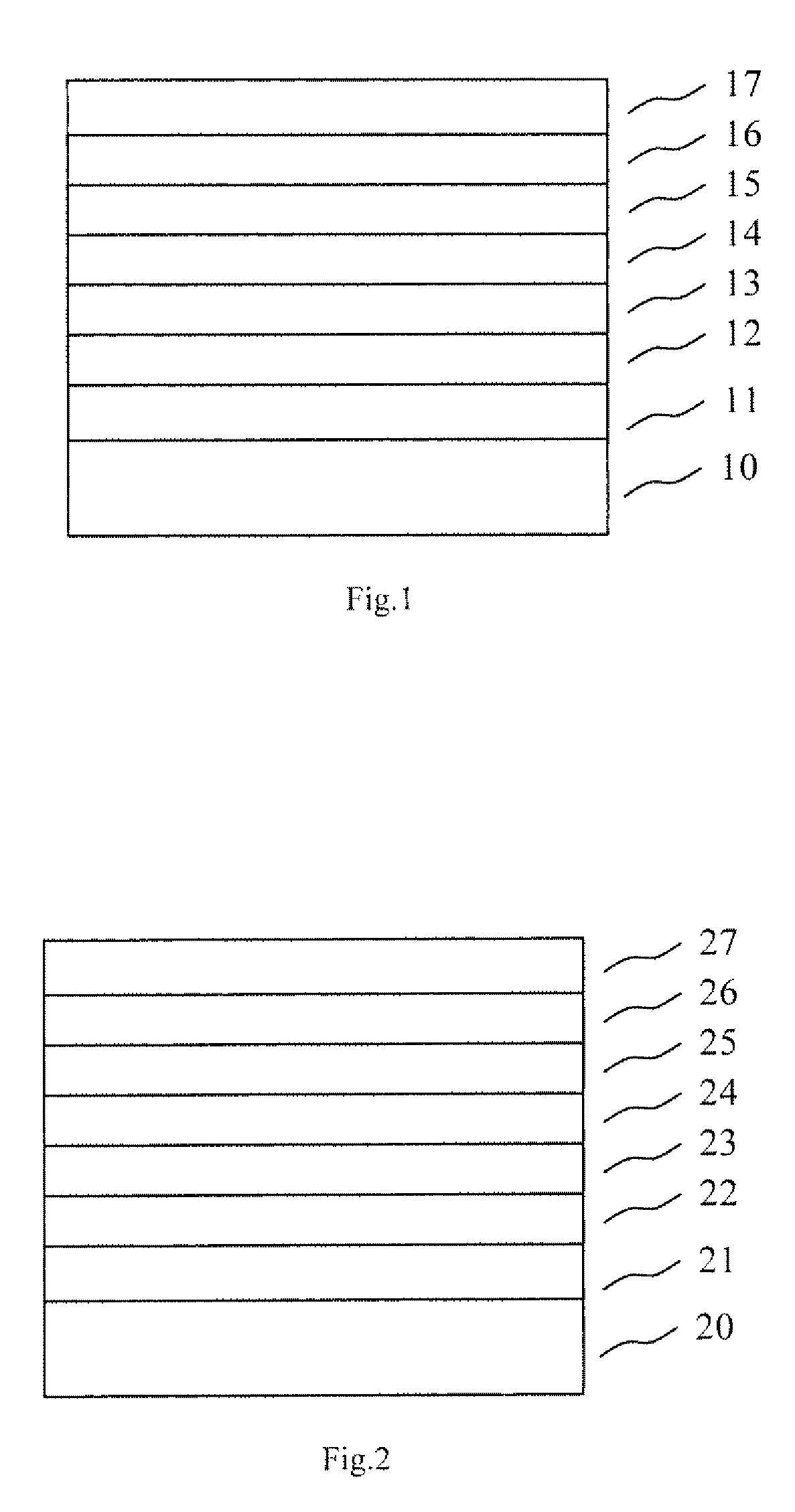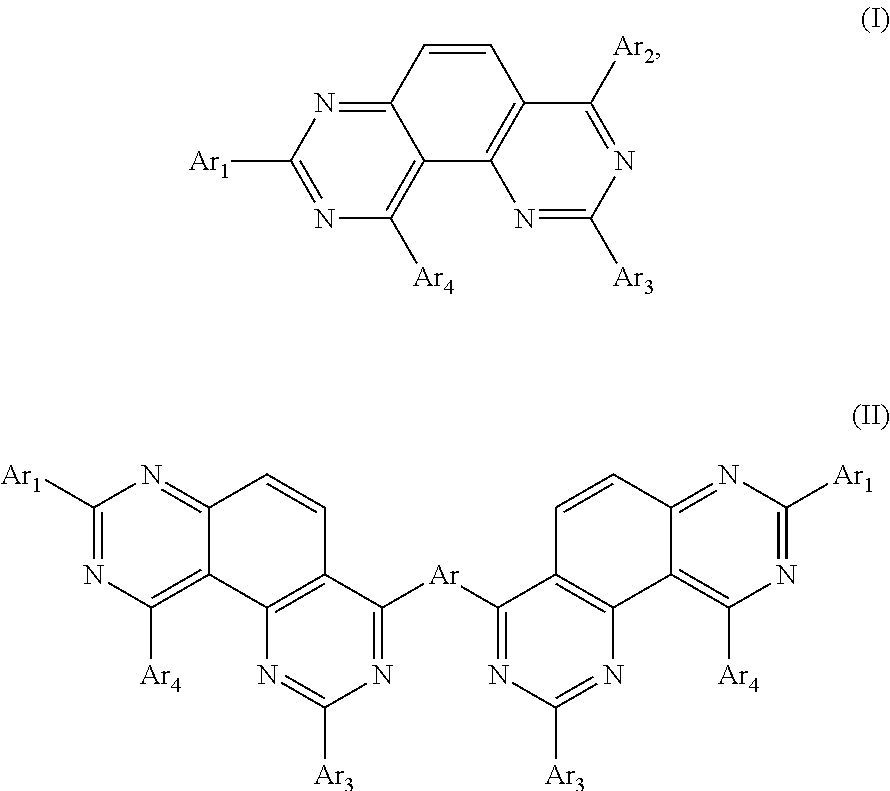Organic electronic device comprising an organic semiconducting material
a semiconducting material and electronic device technology, applied in the field of organic electronic devices comprising organic semiconducting materials, can solve the problems of reducing contact resistance, less common methods, and difficulty in determining electron affinity, and achieve good lumo position for organic light-emitting, good conductivity and charge carrier mobility, and high thermal stability
- Summary
- Abstract
- Description
- Claims
- Application Information
AI Technical Summary
Benefits of technology
Problems solved by technology
Method used
Image
Examples
example 1
Synthesis of
[0073]
[0074]First step: Synthesis of 2-phenyl-7,8-dihydroquinazolin-5(6H)-one (1). All manipulations were carried out in air, without any further purification of commercial solvents / chemicals.
[0075]
2-((dimethylamino)methylene)cyclo-16.7 g (100 mmol)hexane-1,3-dioneBenzamidinium Hydrochloride19.2 g (110 mmol)N-ethyl-N-isopropylpropan-2-amine20 mL (120 mmol)Ethanol100 mL
[0076]A suspension of 2-((dimethylamino)methylene)cyclohexane-1,3-dione (16.7 g) and benzamidinium hydrochloride (19.2 g) in 75 mL Ethanol is refluxed in a 250 mL 2 neck-flask equipped with a reflux condenser and a dropwise addition funnel. The suspension turns into a solution upon boiling, after what a solution of N-Ethyl-N-isopropylpropane-2-amine in 25 mL Ethanol is added dropwise within 20 min. The solution turns from yellow to orange and is heated at reflux for 3 hours. The reaction mixture is cooled down to room temperature during which time a thick yellow precipitate appears.
Work Up
[0077]The suspensi...
example 2
Synthesis of
[0105]
[0106]First step: Synthesis of 2-phenyl-7,8-dihydroquinazolin-5(6H)-one (1). All manipulations were carried out in air, without any further purification of commercial solvents / chemicals.
[0107]
2-((Dimethylamino)methylene)16.7 g (100 mmol)cyclohexane-1,3-dioneBenzamidinium Hydrochloride19.2 g (110 mmol)N-ethyl-N-isopropylpropan-2-amine20 mL (120 mmol)Ethanol100 mL
[0108]A suspension of 2-((dimethylamino)methylene)cyclohexane-1,3-dione (16.7 g) and benzamidinium hydrochloride (19.2 g) in 75 mL ethanol is refluxed in a 250 mL 2 neck-flask equipped with a reflux condenser and a dropwise addition funnel. The suspension turns into a solution upon boiling, after what a solution of N-ethyl-N-isopropylpropane-2-amine in 25 mL ethanol is added dropwise within 20 min. The solution turns from yellow to orange and is heated at reflux for 3 hours. The reaction mixture is cooled down to room temperature during which time a thick yellow precipitate appears.
Work Up
[0109]The suspensio...
example 3
Synthesis of
[0135]
[0136]First step: Synthesis of 2-(naphthalen-1-yl)-7,8-dihydroquinazolin-5(6H)-one (7). All manipulations were carried out in air, without any further purification of commercial solvents / chemicals.
[0137]
2-((Dimethylamino)methylene)cyclohexane-1,3-dione16.7 g (100 mmol)Benzamidinium Hydrochloride19.2 g (110 mmol)N-ethyl-N-isopropylpropan-2-amine20 mL (120 mmol)Ethanol100 mL
[0138]A suspension of 2-((dimethylamino)methylene)cyclohexane-1,3-dione (16.7 g) and benzamidinium hydrochloride (19.2 g) in 75 mL ethanol is refluxed in a 250 mL 2 neck-flask equipped with a reflux condenser and a dropwise addition funnel. The suspension turns into a solution upon boiling, after what a solution of N-ethyl-N-isopropylpropane-2-amine in 25 mL ethanol is added dropwise within 20 min. The solution turns from yellow to orange and is heated at reflux for 3 hours. The reaction mixture is cooled down to room temperature during which time a thick yellow precipitate appears.
Work Up
[0139]Th...
PUM
| Property | Measurement | Unit |
|---|---|---|
| polarization energy | aaaaa | aaaaa |
| LUMO | aaaaa | aaaaa |
| LUMO | aaaaa | aaaaa |
Abstract
Description
Claims
Application Information
 Login to View More
Login to View More - R&D
- Intellectual Property
- Life Sciences
- Materials
- Tech Scout
- Unparalleled Data Quality
- Higher Quality Content
- 60% Fewer Hallucinations
Browse by: Latest US Patents, China's latest patents, Technical Efficacy Thesaurus, Application Domain, Technology Topic, Popular Technical Reports.
© 2025 PatSnap. All rights reserved.Legal|Privacy policy|Modern Slavery Act Transparency Statement|Sitemap|About US| Contact US: help@patsnap.com



